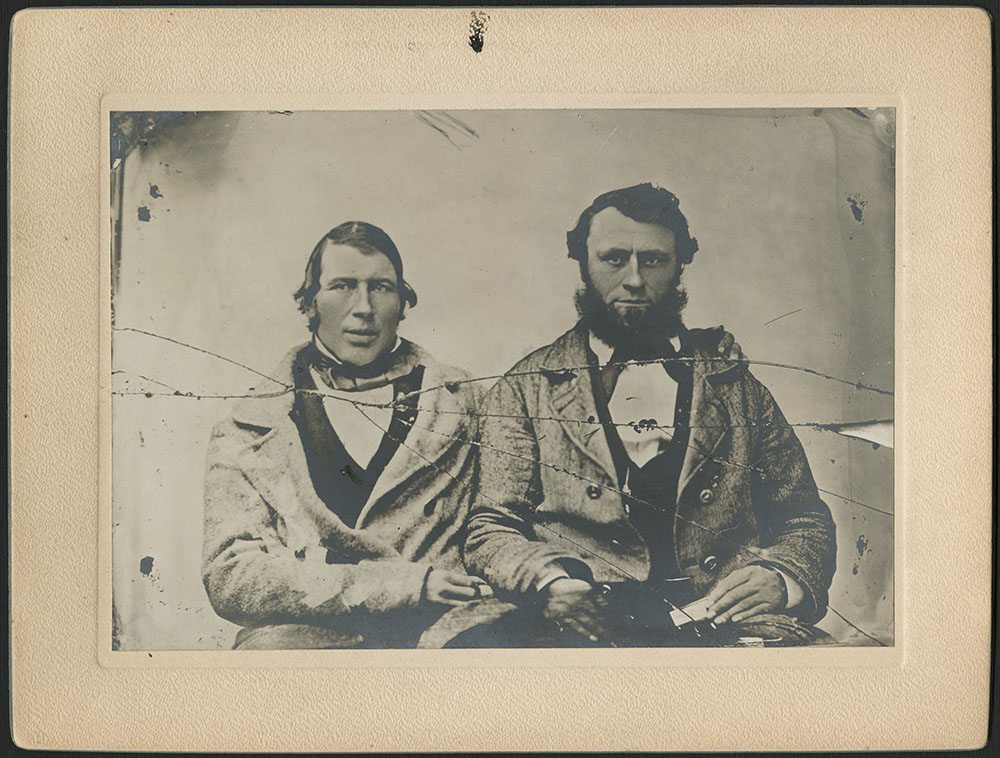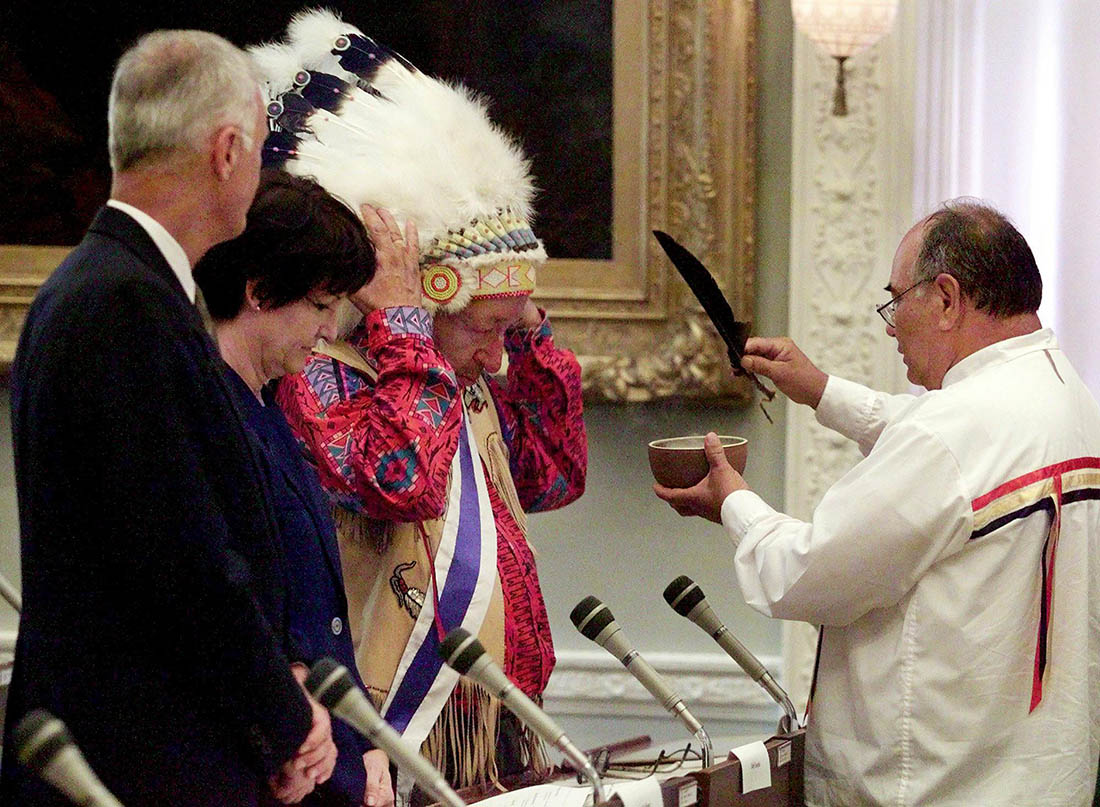Browse "Indigenous Peoples"
-
Article
Inuit Vocal Games
Inuit vocal games describe central Canadian Arctic practices that are both musical and ludic (spontaneous or playful). According to regional differences, these can be divided into several genres with different names.
"https://d2ttikhf7xbzbs.cloudfront.net/media/media/68cae00c-f728-459d-bb87-2162d08774fa.jpg" // resources/views/front/categories/view.blade.php
https://d2ttikhf7xbzbs.cloudfront.net/media/media/68cae00c-f728-459d-bb87-2162d08774fa.jpg
-
Article
Inuit Words for Snow and Ice
It is often said that the Inuit have dozens of words to refer to snow and ice. Ontarian anthropologist John Steckley (in White Lies about the Inuit, 2008) noted that according to popular belief, in Inuktitut, the language of the Inuit from Canada's Eastern Arctic, the number of words for "snow" generally contains the digit 2, and that the total most often cited is 52 different terms.
"https://d2ttikhf7xbzbs.cloudfront.net/media/media/564ff157-335a-409a-81af-13f050b3079a.jpg" // resources/views/front/categories/view.blade.php
https://d2ttikhf7xbzbs.cloudfront.net/media/media/564ff157-335a-409a-81af-13f050b3079a.jpg
-
Article
Inuksuk (Inukshuk)
Inuksuk (also spelled inukshuk, plural inuksuit) is a figure made of piled stones or boulders constructed to communicate with humans throughout the Arctic. Traditionally constructed by the Inuit, inuksuit are integral to Inuit culture and are often intertwined with representations of Canada and the North. A red inuksuk is found on the flag of Nunavut. In Inuktitut, the term inuksuk means "to act in the capacity of a human." It is an extension of the word inuk meaning "a human being." Inuksuit have been found close to archaeological sites dating from 2400 to 1800 BCE in the Mingo Lake region of southwest Baffin Island. (See also Prehistory.) While stone figures resembling human forms are often referred to as inuksuk, such figures are actually known as inunnguaq.
"https://d2ttikhf7xbzbs.cloudfront.net/media/media/fda0c3a3-c613-4196-ba0a-690925ca6c04.jpg" // resources/views/front/categories/view.blade.php
https://d2ttikhf7xbzbs.cloudfront.net/media/media/fda0c3a3-c613-4196-ba0a-690925ca6c04.jpg
-
Article
Inuktitut Words for Snow and Ice
It is often said that the Inuit have dozens of words to refer to snow and ice. Anthropologist John Steckley, in his book White Lies about the Inuit (2007), notes that many often cite 52 as the number of different terms in Inuktitut. This belief in a high number of words for snow and ice has been sharply criticized by a large number of linguists and anthropologists.
"https://d2ttikhf7xbzbs.cloudfront.net/media/media/1c4db935-fcf6-4b0d-a8f4-7ab6c8a30a3c.jpg" // resources/views/front/categories/view.blade.php
https://d2ttikhf7xbzbs.cloudfront.net/media/media/1c4db935-fcf6-4b0d-a8f4-7ab6c8a30a3c.jpg
-
Article
Haudenosaunee (Iroquois)
The Haudenosaunee, or “people of the longhouse,” commonly referred to as Iroquois or Six Nations, are members of a confederacy of Indigenous nations known as the Haudenosaunee Confederacy. Originally a confederacy of five nations inhabiting the northern part of New York state, the Haudenosaunee consisted of the Seneca, Cayuga, Oneida, Onondaga and Kanyen’kehà:ka (Mohawk). When the Tuscarora joined the confederacy early in the 18th century, it became known as the Six Nations. Today, Haudenosaunee live on well-populated reserves — known as reservations in the United States — as well as in off-reserve communities.
"https://d2ttikhf7xbzbs.cloudfront.net/media/media/c78ecb73-d7ac-4834-bc1e-a6d6bf206331.jpg" // resources/views/front/categories/view.blade.php
https://d2ttikhf7xbzbs.cloudfront.net/media/media/c78ecb73-d7ac-4834-bc1e-a6d6bf206331.jpg
-
Article
Jackson Beardy
Jackson Beardy (also known as Quincy Pickering Jackson Beardy), Oji-Cree artist (born 24 July 1944 in Island Lake, MB; died 8 December 1984 in Winnipeg, MB). Beardy was part of the Woodlands School of Indigenous art, and in 1973 he became part of a group of Indigenous artists popularly known as the Indian Group of Seven. His stylized artworks — sometimes painted on canvas, birch bark or beaver skins — were often concerned with the interdependence of humans and nature. They also tended to depict figures from Ojibwe and Cree oral traditions. From the late 1960s to his death in the early 1980s, Beardy promoted Indigenous art as a valid category of contemporary art. His influence as a Woodland artist has contributed to the development of contemporary Indigenous art in Canada.
"https://d2ttikhf7xbzbs.cloudfront.net/media/media/a78f261e-39c7-450a-bd19-466a86a5742c.jpg" // resources/views/front/categories/view.blade.php
https://d2ttikhf7xbzbs.cloudfront.net/media/media/a78f261e-39c7-450a-bd19-466a86a5742c.jpg
-
Article
Jean Cuthand Goodwill
Jean Cuthand Goodwill, OC, nurse, public servant and Indigenous health and education advocate (born 14 August 1928 on the Poundmaker Cree Nation, SK; died 25 August 1997 in Regina, SK). Cuthand Goodwill was one of the first Indigenous registered nurses in Canada. In 1974, she cofounded Indian and Inuit Nurses of Canada (now known as the Canadian Indigenous Nurses Association). She was a lifelong organizer, writer and educator who promoted First Nations health and culture.
"https://d2ttikhf7xbzbs.cloudfront.net/media/single_use_images/Jean_Cuthand_Goodwill96.jpg" // resources/views/front/categories/view.blade.php
https://d2ttikhf7xbzbs.cloudfront.net/media/single_use_images/Jean_Cuthand_Goodwill96.jpg
-
Article
Jean-Louis Riel
Jean-Louis Riel (also known as Louis Riel Sr.), Métis leader, farmer, miller (born in 1817 in Île-à-la-Crosse, Saskatchewan; died in 1864 in Saint-Boniface, Manitoba). Riel rallied hundreds of Métis people in support of Métis defendants against the Hudson’s Bay Company in the 1849 Sayer trial. A landmark case in the history of the Canadian West, the Sayer verdict re-established free fur trade in the Red River Colony. By the 1850s, Jean-Louis Riel had become a leader of the French-Canadian community in the Red River. His role in having the French language used in the Assiniboia courts, and in gaining representation for the Métis on the Council of Assiniboia, helped to cement this status. Riel’s outspoken stance on Métis rights and autonomy significantly influenced his son, Louis Riel, who went on to become arguably the most significant historical Métis leader.
"https://d2ttikhf7xbzbs.cloudfront.net/media/media/3b6c75e4-12c4-4513-9f68-a9f2c32e3071.jpg" // resources/views/front/categories/view.blade.php
https://d2ttikhf7xbzbs.cloudfront.net/media/media/3b6c75e4-12c4-4513-9f68-a9f2c32e3071.jpg
-
Article
Jeannette Corbiere Lavell
Jeannette Vivian Corbiere Lavell (called Keewednanung, “North Star” in the Anishinaabe language), CM, activist, educator and community worker (born 21 June 1942 in Wikwemikong, ON). Corbiere Lavell, an Anishinaabe (Ojibwe) woman, was one of several Indigenous women who brought increased public awareness to the gendered discrimination that First Nations women faced because of status law, namely section 12(1)(b) of the Indian Act. Her efforts were central to revising patriarchal (male-dominated) aspects of Canadian legal code.
"https://d2ttikhf7xbzbs.cloudfront.net/media/media/2ea39e9a-9c51-4398-a837-30842473adce.jpg" // resources/views/front/categories/view.blade.php
https://d2ttikhf7xbzbs.cloudfront.net/media/media/2ea39e9a-9c51-4398-a837-30842473adce.jpg
-
Article
Jeff Barnaby
Jeff Barnaby, writer, director, editor, composer (born 2 August 1976 in Listuguj Reserve, QC; died 13 October 2022 in Montreal, QC). Jeff Barnaby was a multitalented Mi’kmaq filmmaker who worked mainly in the horror genre. His award-winning films, such as Rhymes for Young Ghouls (2013) and Blood Quantum (2019), are notable for incorporating gritty portrayals of Indigenous characters into stories with elements of science fiction, body horror and magic realism. Barnaby was a rising talent in Canadian and Indigenous cinema. He died of cancer at the age of 46.
"https://d2ttikhf7xbzbs.cloudfront.net/JeffBarnaby/CP2453732_resized.jpg" // resources/views/front/categories/view.blade.php
https://d2ttikhf7xbzbs.cloudfront.net/JeffBarnaby/CP2453732_resized.jpg
-
Article
Jerry Potts
Jerry Potts, or Ky-yo-kosi, meaning "Bear Child," scout, guide, interpreter (b at Ft McKenzie, US 1840; d at Fort Macleod, Alta 14 July 1896).
"https://d2ttikhf7xbzbs.cloudfront.net/JerryPotts.jpg" // resources/views/front/categories/view.blade.php
https://d2ttikhf7xbzbs.cloudfront.net/JerryPotts.jpg
-
Article
Jimmy Rattlesnake
Jimmy Rattlesnake, baseball player (born 1909 in Hobbema [now Maskwacis], Alberta; died 17 April 1972 in Hobbema). A crafty and durable left-handed pitcher, Jimmy Rattlesnake was one of Canada’s first Indigenous baseball stars. He dominated prize money tournaments in Alberta and Saskatchewan in the 1930s and 1940s. Some reports indicate that he also briefly pitched professionally in the United States. Often compared to African American pitcher Satchel Paige, Rattlesnake was inducted into the Canadian Baseball Hall of Fame in 2021.
"https://d2ttikhf7xbzbs.cloudfront.net/Jimmy Rattlesnake2 - Copy (1) (002).jpg" // resources/views/front/categories/view.blade.php
https://d2ttikhf7xbzbs.cloudfront.net/Jimmy Rattlesnake2 - Copy (1) (002).jpg (002).jpg)
-
Article
John Henry Yahba
John Henry Yahba, Ojibwe farmer, soldier, war hero, labourer (born 1 October 1880 at Saugeen First Nation, ON; died 29 November 1953 in Chippewa Hill, ON). Yahba served in the Canadian Expeditionary Force during the First World War. In the closing month of that war, he was awarded the Distinguished Conduct Medal for his heroism in battle on the Western Front. (See also Indigenous Peoples and the World Wars.)
"https://d2ttikhf7xbzbs.cloudfront.net/a2016-016-001-p85-cropped-john-henry-yahba2.jpg" // resources/views/front/categories/view.blade.php
https://d2ttikhf7xbzbs.cloudfront.net/a2016-016-001-p85-cropped-john-henry-yahba2.jpg
-
Article
John Joe Sark
John Joe Sark, Mi'kmaw activist, spiritual leader, author, keptin (captain) (born August 1945 on Lennox Island, PEI; died 8 January 2023 in Johnstons River, PEI). John Joe Sark was an ardent advocate for Indigenous rights, who devoted his energies toward fighting discrimination and injustice.
"https://d2ttikhf7xbzbs.cloudfront.net/JohnJoeSark/CP2875861_resized.jpg" // resources/views/front/categories/view.blade.php
https://d2ttikhf7xbzbs.cloudfront.net/JohnJoeSark/CP2875861_resized.jpg
-
Article
Jordan's Principle
Jordan’s Principle is a child-first principle that ensures First Nations children can access the same public services as other children in Canada. Jordan’s Principle is named for Jordan River Anderson, a young Cree boy who died at the age of five after waiting for home-based care that was approved when he was two but never arrived because of a financial dispute between the federal and provincial governments. Jordan’s Principle was put in place to ensure a tragedy like this never happens again.
"https://d2ttikhf7xbzbs.cloudfront.net/jordans-principle-logo.png" // resources/views/front/categories/view.blade.php
https://d2ttikhf7xbzbs.cloudfront.net/jordans-principle-logo.png
